#genealogy research
Text

The unspoken history hidden behind a surname
ByLolly Bowean
Chicago Tribune
•
Dec 26, 2017 at 8:00 am
Only the truly curious even ask.
And when a Harvard University student recently inquired about my name, she was clear that she wanted to know about my surname. She repeated it three times out loud and then began probing for something deeper.
She didn’t have to say it, but I knew she was trying to better understand my heritage and ethnic background. My surname, Bowean, is puzzling. And for some, it doesn’t match my physical presence.
When I’m in the Boston region, people ask me if it’s French and I think they are trying to determine if my heritage is Haitian. Others will ask if it’s Celtic, a question that would connect me to the Irish.
The truth is, my last name was probably supposed to be Bowen, but somewhere in the past someone misspelled it and the lives of my family clan were forever changed.
This was a common occurrence. Some Southern African-Americans struggled with literacy after emancipation, and so names took on new spellings. In other cases, white officials didn’t bother to document the correct spellings on public records and the mistakes lived on.
I learned this when I tried to research the history of my last name.
In this country, there are hundreds of Bowens.
Yet, my immediate relatives are the only people I have found with the “Bowean” last name.
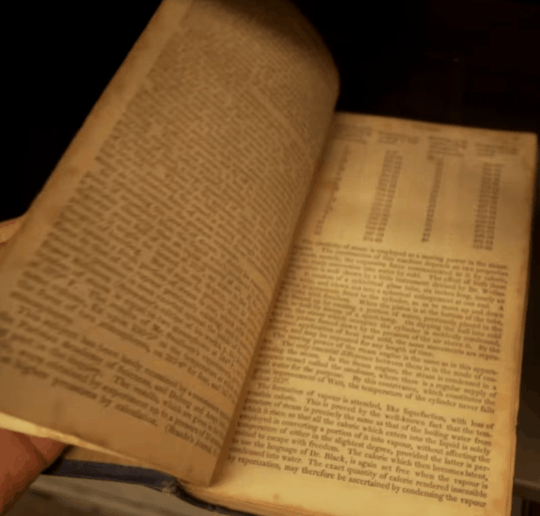
I explained this all to the young, curious student. I went on to tell her that the Bowean surname came to my people through marriage.
Before we were Boweans, we were Norwoods and Wakefields rooted in a small town in western North Carolina — near the mountains. Those names are connected back to England.
“Those are my people,” I told her.
“I know some Norwoods and some Wakefields from western North Carolina,” she piped up, almost with an instant giddy excitement. It seemed that for a moment she thought we had found common ground. I’m sure she thought that maybe we knew some of the same people.
The next sentence she almost whispered: “But they’re white.”
As we both stood in the silence, we didn’t speak about the legacy of American slavery.
Yet this is the moment when race and what it means to be African-American comes creeping into the most fleeting of encounters. It’s these unexpected confrontations with history that trigger what writer and social commentator James Baldwin called the “constant state of rage.”
I didn’t tell the student that during slavery, African-Americans were assigned names by their owners, and many times didn’t even have a surname, records show. I didn’t talk about how those residents were at times given the last name of their owner so that they could be identified as that white family’s property.
I also didn’t bother to talk about how, even after the 13th Amendment brought enslaved people a form of freedom, some chose the plantation name as their last name in order to reveal where they were from. African people held on to these names for many reasons — one being the hope to reunite with other family members who would only be able to identify them by these familiar markers.
These are the names that so many African Americans still wear.
The decision to stay bound to these names is deeply personal. I would never change my name — even if I married — mainly because it connects me to a fragmented people. It is the name that binds us together. And I hold on to hope that my relatives, disconnected long ago, can locate me through that shared legacy.
It is in these innocent moments that the troubling history of this country becomes real and the residue reveals itself as still present. I’ve never been ashamed that I am a descendant of people who were enslaved. Yet it is in subtle, seemingly innocent moments that the trauma strikes me.
I began to feel weighted as I stood staring at the college-age woman with a classic, sophisticated Latin name that means purity. I felt the weariness of being pushed into an emotional space and frustrated from having to contemplate whether to delve deeper into a topic I didn’t expect during idle small talk.
Then I remembered that this history is one we don’t like to discuss anyway. We were only making small talk.
“There’s probably a relationship between the two families,” the African-American one and the white one, I remember telling the student. “But I don’t know exactly, specifically, what it is.”
And then to be polite, we left the rest unspoken and parted ways.

#kemetic dreams#african#african culture#southern african americans#afrakan#afrakans#africans#slave names#irish#celtic#european names#ancestry#ancestry.com#african ancestry#family history#genealogy research#lineage
136 notes
·
View notes
Text

lewyn and his son ced :)
he gave him pretzel bread and is asking erinys if toddlers can have pretzel bread
#fe4#fire emblem#fire emblem genealogy of the holy war#genealogy research#fe lewyn#jugdral#fe ced#lewyn is trying to be a good dad#he just doesn’t know how kids work#erinys knows barely anything more#look lewyn was a traveling bard just doing some exploring#and erinys is a soldier who is apart of the four heavenly knights#they wouldn’t have had time to learn about children before hand
14 notes
·
View notes
Text
Spelman Seminary, companionship, Sophia B. Packard, and Harriet E. Giles

Harriet Elizabeth "Hattie" Giles and Sophia Brett Packard in a photograph sometime before 1891. Image from Spelman College Archives and NYPL.
In 1881, Sophia Brett Packard founded Atlanta Baptist Female Seminary with her longtime companion, Harriet E. Giles. The school would later be renamed Spelman Seminary in 1884 in honor of John D. Rockefeller's wife, Laura Celestia "Cettie" Spelman, who was an active abolitionist and school teacher, since the latter had paid the balance to keep the school open, which opened its doors in 1888. Sophia would continue onward on the school's board of trustees, then as president until her death in June 1891, when there were 464 students and faculty of 34. There's more to this story than the four paragraphs on Sophia's Wikipedia page.
Sophia, my fifth cousin five times removed, was born in New Salem, Massachusetts in January 1824 to Winslow Packard (1790-1852) and Rachel Freeman (1788-1844). She had five siblings: Joseph Fairbanks (1812-1883), Jane (b. 1815), Mary (1815-1838), Hubbard Vaughn (1817-1861), and Rachel Maria (b. 1818). She would graduate from the Charleston Female Seminary in Massachusetts, work at the Connecticut Literary Institution in Suffield, be secretary for the American Baptist Home Mission Society. By the early 1880s she was committed to helping improve education for Black people, specifically Black women, in the South. She would later be described as a "woman of rare executive ability" and having an earnest, strong character. [1]
There is more to be said. You may have noticed earlier that I described Harriet E. Giles as her life-long companion. This is first evidenced by the fact that Sophia died from sickness while on a summer vacation with Harriet, and would be buried in Athol, Massachusetts. Harriet, who lived until 1909, and born in New Salem, Massachusetts like Sophia, would become the president of Spelman Seminary when Sophia died. One writer would call Harriet and Sophia a lesbian power couple, noting that they met each other in the mid-1850s when Harriet was a student at New Salem Academy and Sophia was the preceptor. Both would be buried next to one each other in Silver Lake Cemetery. They would also be described as "close friends and supportive coworkers" by Harry G. Lefever in his article on the early origins of Spelman College. He also noted note the New England-progressive outlook they brought to the school, noting their emphasis on liberal and industrial courses, but employed assumptions about gender roles, which became part of the curriculum while being self-sacrificing and putting others before themselves. At the same time, they never fundamentally challenged social injustices or inequities, either by staying silent about redistribution of land for formerly enslaved peoples, not actively lobbying to end lynching within the South, or having Black people in leadership positions. [2]
Further evidence shows Harriet and Sophia living together in Suffield, Hartford, Connecticut in 1860, within the Mather household, in this below census extract:

Sophia and Harriet are highlighted by a yellow box. Source is 1860 United States Federal Census for Sophia B Packard, Connecticut, Hartford, Suffield, Year: 1860; Census Place: Suffield, Hartford, Connecticut; Roll: M653_79; Page: 667; Family History Library Film: 803079
The same is the case in 1865, when they are living in the same household in Worcester, Massachusetts, along with many other teachers and students. She would still be living in Worcester, Massachusetts until at least 1867. At first I couldn't find her in the 1870 census, and her 1890 passport application does not mention Harriet. However, digging into it more, I found them together in Suffolk, Massachusetts, and it turns out that Harriet submitted a passport application at the same time as Sophia. Additionally, when Harriet died in November 1909 of pneumonia, an obituary in The Sumpter Enterprise at the time described Sophia as Harriet's "friend and co-worker". The Atlanta Constitution would use similar language in their obituary. They were both called "devoted Christian woman" in another article about Spellman, which isn't surprising considering Sophia had worked in a church and what became Spellman was originally in the basement of a church before moving to a new location. [3]
Otherwise, a 1853 student lists for New Salem Academy note that Harriet's father, Samuel, is the secretary of the academy, Harriet as a teacher of music. Sophia is not listed there. However, she is listed as a preceptress in 1855 and Samuel is still secretary of the school, and Harriet is a student in the school's classical department. I also found them together in the 1880 census, boarding on 275 Shawmut Avenue (which is seemingly just an apartment building) in Boston within the Ryder household, along with many other boarders. [8] Harriet would also write a moving eulogy to Sophia, and mentions "loving companionship" which is undoubtedly a way to allude to the romantic relationship they had together, whether it can be called a domestic partnership, romantic friendship, or something else:
It is not necessary to euloigize one so widely known. Her work speaks for her; and the monuments she has erected, will endure from generation to generation, in the lives made better by her influence. How large her bundle of sheaves! How thickly studded her crown with stars for those she has won to Christ! We mourn not for her, but for the work, and the workers who will so greatly miss her loving companionship and wise counsels. Surely "They that be wise shall shine as the brightness of the firmament, and they that turn many to righteousness as the stars forever and ever."
Both also opened the Rollstone School in March 1859 together, which ended after both accepted teaching positions at the Connecticut Literary Institution. They both, would also, teach at the Oread Institute in Worchester from 1864 to 1867, with Sophia as co-principal and Harriet as teacher of ornamentals and music. They also both co-founded the Woman's American Baptist Home Mission Society in 1877.

"Sophia B. Packard and Harriet E. Giles with Spelman Seminary Students" in 1886, via National Alumnae Association of Spelman College
Spelman Seminary would later become Spelman College when its name changed in 1924. Otherwise, one article in The Springfield Daily Republican on November 25, 1939, possibly accessed using one of the libraries here, notes that an oil painting of Harriet was gifted to the Swift River Valley Historical Society. It is likely still in their collections, even though it is strange since the society wasn't incorporated until 1962.
While we don't know everything about Sophia, Harriet, and their relationship, which some have described as an iconic same-sex couple among many others, we can say that their legacy certainly lives on to this day.
Notes
[1] The National Cyclopaedia of American Biography, Vol. 2 (James T. White & Company. 1921), 270-271; "Spelman - Packard" clipping in The Boston Weekly Globe, Boston, Massachusetts, 30 Jun 1891, Page 3.
[2] The National Cyclopaedia of American Biography, Vol. 2 (James T. White & Company. 1921), 271; "Spelman - Packard" clipping in The Boston Weekly Globe, Boston, Massachusetts, 30 Jun 1891, Page 3; "Oread Institute," Lost Womyn's Space, Apr. 27, 2011; Riese Bernard, "16 Lesbian Power Couples From History Who Got Shit Done, Together," Autostraddle, Mar. 31, 2017; Harry G. Lefever, "The Early Origins of Spelman College," The Journal of Blacks in Higher Education No. 47 (Spring, 2005), pp. 60-63.
[3] Massachusetts, U.S., State Census, 1865 for Sophia B Packard, Worcester, Worcester Ward 7, image 4; U.S., City Directories, 1822-1995 for Sophia B Packard, Massachusetts, Worcester, 1867, Worcester, Massachusetts, City Directory, 1867, Image 173; U.S., Passport Applications, 1795-1925 for Sophia B Packard, Passport Applications, 1795-1905, 1888-1890, Roll 344 - 01 Mar 1890-31 Mar 1890, Image 368; 1870 United States Federal Census for Hattie Giles, Massachusetts, Suffolk, Boston Ward 08, Year: 1870; Census Place: Boston Ward 8, Suffolk, Massachusetts; Roll: M593_645; Page: 39A; U.S., Passport Applications, 1795-1925 for Harrich Elizabeth Giles, Passport Applications, 1795-1905, 1888-1890, Roll 349 - 09 May 1890-16 May 1890, Image 43; "Harriett Giles obituary - clip 1" in The Sumter Enterprise, Epes, Alabama, 02 Dec 1909, Page 3; "Harriett Giles obituary - clip 2" in The Sumter Enterprise, Epes, Alabama, 02 Dec 1909, Page 3; "Miss Harriett Giles Dead; Was President of Spellman" in The Atlanta Constitution, Atlanta, Georgia, 14 Nov 1909, Page 8; "Death notice for Harriett Giles" in The Clayton Record, Clayton, Alabama, 26 Nov 1909, Page 1; "Spellman Seminary" in The Rochester Daily Register-Gazette, Feb. 16, 1898, via Ancestry.
[4] U.S., High School Student Lists, 1821-1923 for Harriette E Giles, New Hampshire, New Salem Academy, 1853, pages 2, 3 (exact source is Catalogue of Trustees, Instructors and Students of New Salem Academy, Massachusetts, for the year ending November 10, 1853 (Greenfield, MA: Charles A. Mirick, 1853), 2-3); U.S., High School Student Lists, 1821-1923, New Hampshire, New Salem Academy 1855, page 3-4, 6 (exact source is Catalogue of Trustees, Instructors and Students of New Salem Academy, New Salem, Mass., for the year ending November 15, 1855 (Greenfield, MA: Charles A. Mirick, 1853), 3-4, 6); 1880 United States Federal Census for Hattie S. Giles, Massachusetts, Suffolk, Boston, 715, Year: 1880; Census Place: Boston, Suffolk, Massachusetts; Roll: 558; Page: 62A; Enumeration District: 715.
Note: This was originally posted on May 8, 2023 on the main Packed with Packards WordPress blog (it can also be found on the Wayback Machine here). My research is still ongoing, so some conclusions in this piece may change in the future.
© 2023 Burkely Hermann. All rights reserved.
#lesbians#spelman college#sophia b packard#harriet giles#lgbtq#packards#genealogy#ancestry#genealogy research#black women#black history#black lives matter#suffield#baptists#lynching#connecticut#census#19th century
2 notes
·
View notes
Text
The "rules of genealogical research": Responding to Tanner's "Genealogy Star" blog

An image from a post on familytree.com titled "Long Lost Relatives from Across the Aisle"
In late December James L. Tanner wrote, on his "Genealogy Star" blogspot, about genealogical research in the age of the internet. He wrote that "fundamental rules of genealogical research" necessitate that every conclusion cite a record or document.He added that "genealogy is not something you just make up in your spare time. The whole idea is that genealogy is based on history." I write this post not to disagree with him, but to the contrary, to agree with him with a doubt.
Reprinted from my History Hermann WordPress blog and Wayback Machine. Originally posted on Jan. 10, 2018.
In the rest of Tanner's post, he notes how the "popular part of genealogy has evolved into a copycat deluge" with content of "record hints" ignored or dismissed, adding that there is "no way to purge the system of the old inaccurate information" meaning that such inaccuracies are "copied as well as the accurate information." He gives examples of the ""Family Data Collection - Deaths" collection (which was "copied from copies") , the "Family Data Collection - Births" collection (similar to the other family data collection), and the "U.S. Social Security Applications and Claims Inde[x]s, 1936-2007" (which could be "accurate, but unless the person looking at the entry goes beyond this entry, there is no way to know if the information is useful") on Ancestry.com. He ends his post by saying the following to the reader:
These are examples of the need to look carefully at the sources and to avoid copying copies. Without a general community-wide awareness of this need, we will keep getting copies of copies and preserving inaccurate information. Part of the blame for this situation lies with the individuals, but more lies with the large online companies who think they have "protected themselves" from criticism by explaining the traps but still promote the traps at the same time.
Before moving on, I'd like to respond to the above recommendations and comments. I agree that it is easy to preserve inaccurate information. However, I think it is horrible that companies like Ancestry and sites like Family Search promote bad records with inaccurate sources. So, you have to be careful with genealogical research without a doubt.
Now, let me add my two cents and personal experience.
When I originally started doing genealogy I was adding sources left and right, copying directly from family trees. These trees made it seem that the family on my mom's side descended from English royalty. I used similar information to "prove" the link from my mom's ancestors to a family of a similar name in England. However, this was all for naught: I only relied on family trees but little else. This meant I had to delete many individuals, deleting the "stinky" parts of my family tree on Ancestry.
Since then, my family tree on Ancestry has become a work in progress. I add and subtract information as needed, from time to time. I use "family trees" as a source but only when other sources are available.I recommend that one avoid other horrible sources like the "American Genealogical-Biographical Index (AGBI)", "Millennium File", "U.S. and International Marriage Records, 1560-1900" and "Web: Netherlands, GenealogieOnline Trees Index, 1000-2015" if at all possible. One of the collections looks like this:
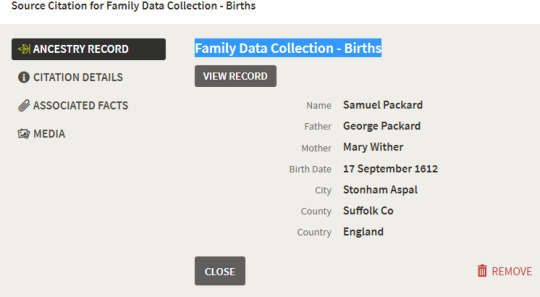
And here is an example of what the "hints" (or the green leaf on profiles) look like on Ancestry:

In this case, both of these hints are about the right person. However, I clicked "ignore" on both because the profile of his father already listed both censuses. I Just wrote "see 1850 census linked on his father's page" (and the same for 1860), adding in the information from his father's page. I did this because I don't currently have an Ancestry.com subscription, but I have information attached to pages from the time I did have a subscription.
Anyway, more to the point of Tanner's post is a biography on Cyrus Winfield Packard. I originally was going to do the entry on Samuel Packard, which is one of the earliest entries on my family tree but I mostly cite my Packed With Packards! blog (which cites original sources), so it probably isn't a good example of good sourcing. So, I present the following biography (with certain identifying of the family tree information blacked out) as an example of something for other researchers to emulate.
Here is the top half of the page:

Census records and marriage records are the mainstay of this biography, whether federal or state censuses (only some states like Massachusetts have them). There is also a peppering of vital records of Massachusetts, Find A Grave, and posts from my Packed with Packards! blog about Cyrus. Now, census records and vital records can be found on ancestry, but if you don't feel like paying for a subscription like yours truly then you can look up the same records on familysearch.org. You need to create an account now, but it is still relatively easy and a free-to-use service. This is an advantage of Family Search over Ancestry without a doubt.
Then there is the second half of the biography:

It continues in the same vein as the top half. I tried my best to source every bit of information I found. You may notice that I used photographs as a source. These come from a collection of Massachusetts Land Records at www.masslandrecords.com which you can search free and online. I was able to find a good many land records that way, which was very helpful to telling the story of Cyrus Winfield Packard. This blog is one, maybe of the first posts connecting my Packed With Packards! blog with this one.
I look forward to hearing your comments.
© 2018-2023 Burkely Hermann. All rights reserved.
3 notes
·
View notes
Text
"Sometimes genealogy seems to have its own language. Documents often contain phrases or words that are no longer used. Historians have often reverted to abbreviations on family charts and documents in order to include more information."
-PBS' genealogy glossary
4 notes
·
View notes
Text
Happy National DNA Day!
As a hobbyist genealogist, DNA, or deoxyribonucleic acid, is an invaluable and fun tool.
I was lucky to have a head start on my family tree, but taking a genetic test through 23andMe (psst, their kits are on sale!!) has allowed me to take my research further.
After submitting my DNA, I connected with relatives that I otherwise may have never known existed. I've filled in branches of my tree that were sturdily brick-walled due to a distant cousin and I putting our heads together to figure out our MRCA, or most recent common ancestor.
It's also given me insight into my ancestry composition! Though Ancestry's database is larger, 23andMe and Ancestry have comparable accuracy rates for their ethnicity estimates. My results have shifted since I took my test in late 2020, but it largely stayed the same.
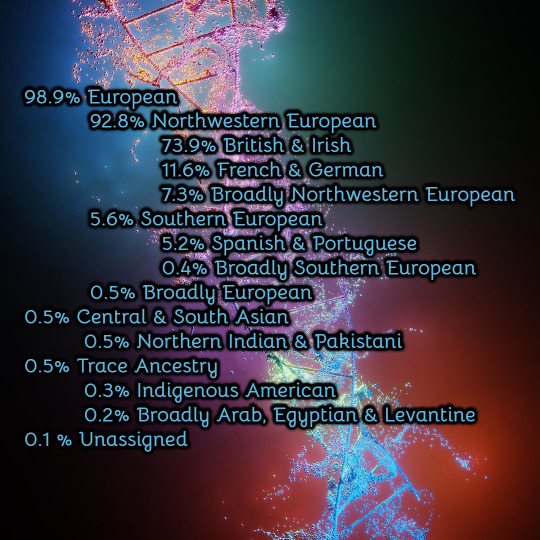
Image Description: An image of a colorful strand of DNA. It is illuminated with a glow and has soft bubbles flowing from it. My DNA results are typed through the center of the image.
Image from BeFunky stock images.
Edited by Keekee Smith with BeFunky.
—————————
Everything outside of my Northwestern European percentage came as a shock to me. The exception is the trace ancestry of Indigenous American DNA, as my family claimed this ancestral ethnicity for generations. The shock with the Indigenous DNA was mainly that it was true to any extent (check out this article from Harvard University's Native American Program to learn more about the "Cherokee Princess Myth"). That's a story for a different post, though!
Initially, I wasn't sure where the Spanish & Portuguese DNA could be from, but I've since learned about an 8th great-grandfather born in Jamaica who allegedly had a Spanish father or mother. I haven't yet verified his information, so it's still unclear if that's my Spanish/Portuguese link but time will tell!
The Asian and Broadly Arab, Egyptian & Levantine DNA blew my mind. There were no family rumors or other inklings that would have ever led me to believe those would show up in my DNA. A quick Google search says that 23andMe goes back about 8 generations, so these bits of DNA likely come from within that range. Wherever it is, though, I've yet to find it!
While some of my branches are fleshed out as far back as a 12th great-grandparent, I still have many lineages brick-walled 3-4 generations back. Truth is, there's just no telling until that ancestor decides to reveal themself.
Until then, I'll keep up the familial work and enjoy the fun little things DNA has to offer. I'm taking a short hiatus from genealogy research to catch up on other responsibilities, but I'll be back to reporting my family's shenanigans in no time.
In the meantime, tell me about your ancestors and their lives! What are some interesting discoveries you've found?
#DNA Day#National DNA Day#DNA#DNA test#DNA testing#genealogy#ancestry#ancestry blog#family research#blog#blogger#writeblr#family tree#23andMe#genealogist#genealogy research#discoveries#writers on tumblr#ancestors
1 note
·
View note
Text
A Newspapers.com weekend - way down the rabbit hole...
Last weekend was, as I’m sure many of you are aware, both a long weekend in Canada and the US, and a free long weekend at Newspapers.com. A dangerous combination indeed.
A recent addition to the Newspapers.com collection is The Hamilton Spectator, published in Hamilton, Ontario, Canada. When I saw the announcement in November, I immediately began searching for my Spong family and saved the…
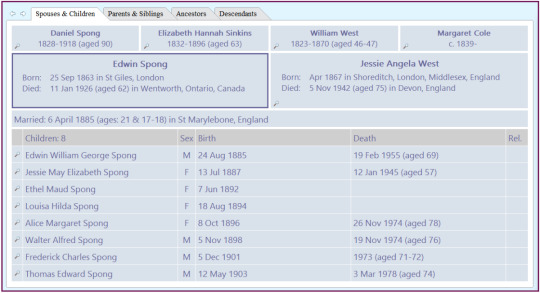
View On WordPress
0 notes
Text
Give the Gift of FOREVER
'Tis the season and I've got some gift ideas which will turn you into a hero for generations to come! Click to learn more.
MEMORY KEEPING 101: SHARE THE LOVE
Start Something with FOREVER
Talk about a gift that keeps on giving! What if a gift you give this Christmas could tell generations you’ll never meet how much you care. That’s what the gift of FOREVER can do.
A Permanent Digital Home
Perhaps the perfect gift for your someone is FOREVER’s permanent online storage they own rather than rent. Phones, tablets and…

View On WordPress
#Crafting Community#Digital Photo Storage#Genealogy Research#Holiday Gifts#Jane Sadek#Lifestyle Blog#Media Digitization#Photo Gifts#Photography#video streaming
0 notes
Text
Beyond Names and Dates: Adding Color to Your Family Tree
When we embark on the journey of discovering our circle of relatives' records, it's easy to wander off in a sea of names and dates. We acquire start certificates, marriage facts, and dusty antique photos, however regularly, those files alone cannot tell the overall story of our ancestors' lives.
Unearthing Personal Stories
The Power of Oral History
One of the most profound approaches to adding vibrancy to your family tree is with the aid of tapping into the oral records within your family. Canvassing grandparents, aunts, uncles, and aged loved ones can disinter priceless stories and perceptivity about your ancestors. These personal testimonies can screen quirks, challenges, and triumphs that may not appear in any legitimate record.
Diary Entries and Letters
If you're fortunate enough to have gotten admission to diaries or letters from the beyond, you've struck gold. Reading their own words can ship you lower back in time and connect you on a profound level.
Placing Your Ancestors in Historical Context
Researching Historical Events
To truly understand your forefathers, it's pivotal to place them within the environment of the times they lived in. Probe the literal events that accommodated their lives, from wars and afflictions to sociable and cultural movements. Knowing the challenges, they faced and the sector they navigated adds depth to your own family narrative.
Explore Local History
Don't restrict your research to just your family; delve into the records of the areas they inhabited. Original libraries, journals, and literal societies can give precious perceptivity to the communities your forbearers were part of, slipping light on their places, professions, and social networks.

The Art of Creative Storytelling
Crafting Engaging Narratives
Use your storytelling skills to carry your ancestors to life on the pages of your family tree.
Incorporating Analogies and Metaphors
To make your own family history genuinely charming, don't forget to incorporate analogies and metaphors. Compare your ancestors' struggles to fashionable-day challenges or use vivid metaphors to paint a photo of their personalities.
In the pursuit of creating your own family tree, it's easy to fixate on names and dates. Still, by embracing the styles cited above, you may revise your genealogical exploration into a rich shade of mortal reviews. Through oral records, particular tales, ancient environments, and creative storytellers, you may breathe cultures into the names of your circle of cousins' trees, making them further than bare dates on a runner.
So, pass beforehand, dig deeper, ask questions, and let the recollections of your ancestors enkindle your passion for the line. As you unveil the candescent shade in their lives, you may discover that your family tree isn't only a report of the hereafter but a living testament to the long-lasting natural spirit.
0 notes
Text




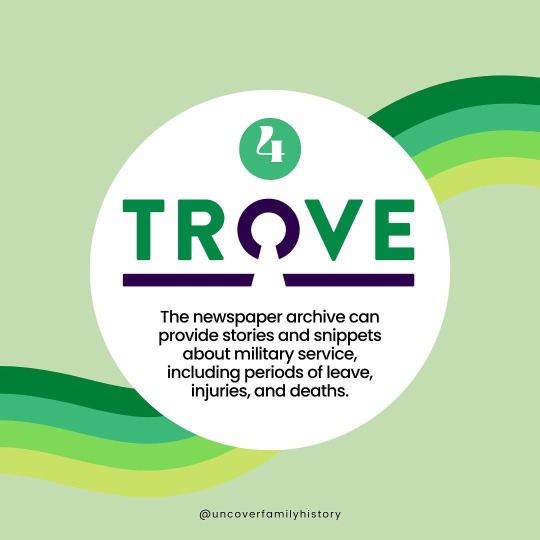
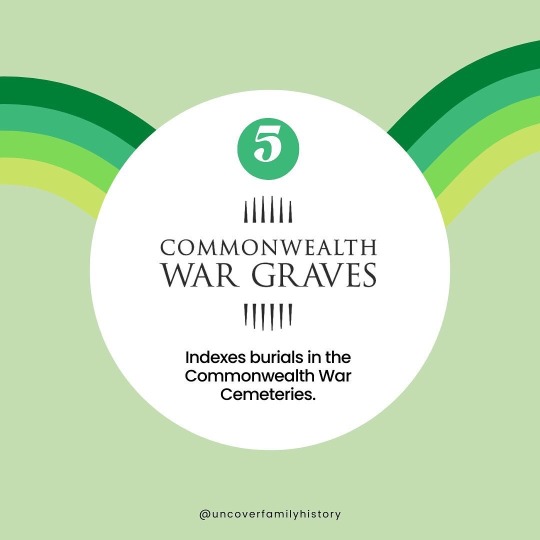

🌹With Remembrance Day having just taken place, it’s the perfect time to spend a little time researching the military service in your family tree.
💚 National Archives of Australia: https://www.naa.gov.au/
🤍 Australian War Memorial: https://www.awm.gov.au/
💚 Department of Veteran Affairs: https://nominal-rolls.dva.gov.au/
🤍 Trove: https://trove.nla.gov.au/
💚 Commonwealth War Graves Commission: https://www.cwgc.org/
🔗For a more detailed overview of these resources, plus more places to search: bit.ly/AusMilitaryRecords
#Remembrance Day#veterans day#family history#ancestry#ancestors#family tree#military history#military service#genealogy research#geneaology#geneablogger#aussieblogger#australianblogger
0 notes
Text
This Week’s Free Genealogy Lookups
This Week’s Free Genealogy Lookups
First-Time User? Click here
Passenger and Immigration Lists Index, the 1500s-1900sPassenger and Immigration Lists: Germans to America, 1850-1874Passenger and Immigration Lists: Germans to America, 1875-1888Passenger and Immigration Lists: Irish to America, 1846-1865

View On WordPress
0 notes
Text
"A man of wealth": Samuel Packard, the Rhode Island slaver [part 1]
In March 2018, I first wrote about Samuel Packard, my great-great-great-great-great grand uncle, and his role in the transatlantic slave trade as a slaver, otherwise known as a slave trader. [1] Thanks to a new database, Enslaved: Peoples of the Historical Slave Trade, I found that Samuel's role as a slaver was much more extensive than I had originally believed. His acts helped reinforce what Isabel Wilkerson describes as a racial caste system that uses rigid, arbitrary boundaries to keep groupings of people apart. [2] Such a system reinforces a social order supported by culture and passes through the generations, with the signal of one's rank in the hierarchical system as determined by race, with terms like "black" and "white" applied to people's appearance. However, Wilkerson argues that caste is rigid and fixed, while race is superficial and subject to change to meet the needs of the dominant caste within the United States. Ultimately, inherited physical characteristics are used to differentiate "inner abilities and group value" and maintain and manage the caste system within the United States. In the case of Samuel, he was part of this system, reinforcing it with his actions time and time again, like some of my other ancestors. [3] However, as I noted in the past, that he was not a slaveowner. This article aims to pull away the false narrative used to cover up the history of enslavement and how offensive the institution of slavery was itself, noting the part Samuel played in this history, recognizing who he is as a person, following the advice of Beth Wylie, a White female genealogist. This article also aims to not make White people comfortable with the past or sugarcoat anything, but challenge existing notions, as suggested by Black genealogist Adrienne Fikes in early June.
Of the 402 ships which sailed from Rhode Island to Africa from 1784 and 1807, 55 of them came from Providence, accounting for 14 percent of the state's slave trade. [4] One of those ships was a sloop named General Greene, registered in Providence. On November 16, 1793, it began sailing from Rhode Island. The ship was owned by Samuel Packard, Cyprian Sterry, Philip Allen, and Zachary Allen. [5] Helmed by a captain named "Ross," the General Greene arrived in Gorée, Senegambia sometime in 1793, with 101 souls loaded onto the ship by force. By the time the ship had reached the Dutch colony of Suriname, sometime in April 1794, only 84 enslaved Black people, who had been trafficked across the Atlantic Ocean, were remaining. This meant that 17%, or 17 people, died during the Middle Passage. In Suriname, enslaved Black people were needed, as were Indigenous people, to make the colony viable, even though enslaved Black people were treated terribly, and many escaped their plantations. [6] The Zachary Allen noted here was undoubtedly the father of the textile manufacturer born in 1795, who was born in 1739. He has been described as a "successful merchant" who amassed a great quantity of capital. It is not known who the "Philip Allen" was and whether the said person was related to the manufacturer born in 1785.
On July 12, 1794, the General Greene returned to its home port somewhere in Rhode Island. The owners had been paid, the ship was not captured, and the enslaved Black people disembarked. In this trip and for all slave ships, the captain was completely in charge, with the duty to "navigate an efficient course, maintain authority over the crew, fill the vessel to capacity with enslaved peoples, and negotiate a high sale price for the enslaved cargo at port markets." [7] Sadly, we do not know the names of the 101 people who were aboard the General Greene in bondage at the beginning of the journey, nor those at the end, we only know the number of those aboard the vessel.
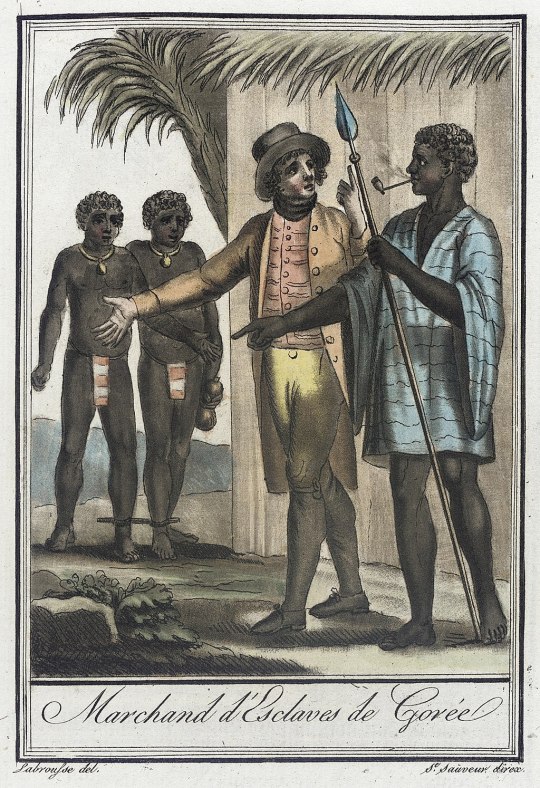
A slave trader of Gorée, engraving of c. 1797, by Jacques Grasset de Saint-Sauveur, via Wikimedia, but in public domain
Gorée is infamous for being the House of Slaves, which was built between 1780 and 1784 by an Afro-French family, the Métis. It has been described as having "one of the slave warehouses through which Africans passed on their way to the Americas," symbolic no matter how many Africans passed through, especially when it comes to its "door of no return." In the case of Senegambia (present-day Senegal, The Gambia, and Guinea-Bissau, portions of Mauritania, Mali, and Guinea), in 1794, it was partitioned between the French and British. This journey may also be the one the Philadelphia Inquirer referred to in September 1794 when it talked about a Captain Samuel Packard traveling from Barbados, which was then part of the British West Indies. [8] As for Cyprian, he was one of the biggest slave traders in Providence, he "financed at least 18 voyages that transported more than 1,500 enslaved persons to the southern United States and the Caribbean during the 1790s."
Later that year, on November 28, 1794, the GeneralGreene departed once more from Rhode Island, this time with John Stanton as the captain. [9] It would go on a 196 day voyage. The ship reached Iles de Los sometime in 1795, with 99 souls forced aboard. When it reached Savannah, Georgia in May of that year, only 88 remained, meaning 11% had died when trafficked across the Atlantic. The General Greene returned back to Rhode Island sometime after June of the same year. Iles de Los is a set of Islands off Conakry, Guinea. At the time, there was a trading post employing workers who repaired ships, and pilots for rivers, on the island. It would be controlled by the British beginning in 1818 and ending in 1904, later to be part of French Guinea from 1904 to 1958. Those on the islands were the Baga people and spoke the Baga language, specifically a Kaloum or Kalum dialect. That same year as the General Greene left the state, the African Union Society of African descendants in Rhode Island was organized in Providence to serve the needs of Black people in the state itself. [10] In Georgia, slavers from Rhode Island, especially in the early 1790s, dominated the slave trade to the state. Samuel and Cyprian were integral to this trade, with the latter described as the "wealthiest ship owner and most active slave trader" in the state. Again, the names of those on the ship were not listed, so we only know the number of those on the ship.
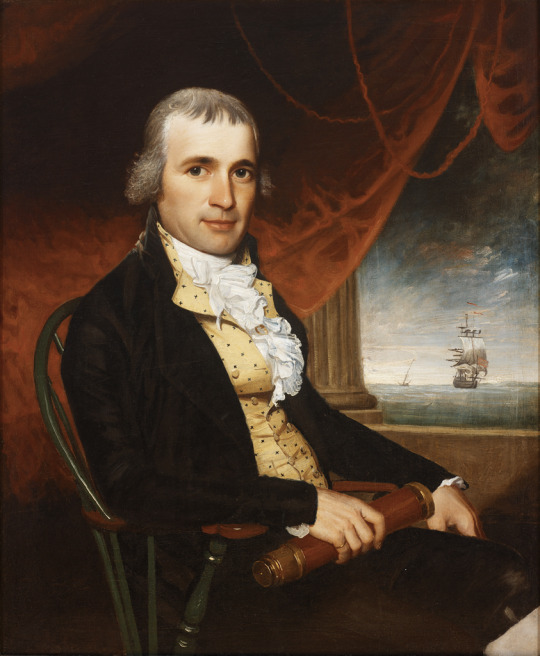
Sometime in 1795, James Earl, a Massachusetts-born artist, released his unsigned 35 x 29 oil painting, on canvas, of Samuel, then 45 years old. RISD described this painting as signaling his "social and professional role in the new republic," as he sits in a Windsor Chair, noting his waistcoat indicates he is "a man of wealth," with the background referring to his "interests in maritime trade." The museum also calls him a "merchant and talented mariner," who owned 39 vessels that sailed from Providence itself. Of course, his role in the slave trade is never mentioned. This is not a surprise, as the 1942 profile of Samuel in the Rhode Island History notes the same. [11] Furthermore, the absence of the slave trade from Earl's painting is not unique. As Edna Gabler points out, Black people in paintings by Charles Wilson Peale, John Trumbull, and others, "occupy subordinate positions, are rarely identified by name, and are most often used as props, background accessories, or foils," or, in this case, not mentioned at all.
The following year, on October 24, 1795, the Ann, a ship registered in Providence, and owned by Samuel and Cyprian, departed from Rhode Island. [12] Unlike the other journeys, Samuel was the captain. The ship would land somewhere on the African continent, with 133 people forced aboard. 70% of these African captives were men, about 26% were boys, and around 4% were women. Almost 26% of those aboard were children. 13 of these souls, 10% to be exact, would die during the Middle Passage. When the ship arrived at Spanish-controlled city of Havana, in Cuba, sometime in August 1796, only 120 remained, and all those in bondage disembarked there, with Samuel and the ship returning to Rhode Island. At the time, Havana was one of "the largest slave markets in the world," with over 600,000 Africans taken from West Africa and shipped to Cuba over three centuries. The Ann would later be sold in Havana, seemingly in September 1796. [13] Like with the other ships noted in this article, those in bondage aboard the Ann are not named, a clear form of dehumanization.

An enslaved Afro-Cuban in the 19th century, via Wikimedia Commons
At the time, landowners were beginning to win concessions that would change how land would be owned in Cuba, a process that would continue until 1820. [14] Values of land were rising and Cuban planters were consolidating their power on the island, importing machines from other European colonies, like those in the British West Indies, to strengthen the sugar industry. When Samuel landed in Cuba, he would have seen the beginning of changes in Cuban society, with population numbers beginning to rise, as did profits and agricultural production, with new position for the class of Cuban Creoles. The number of enslaved Black people on the island increased as demand for more workers continued to grow, especially after the import of White workers wasn't successful. An average of 1,143 enslaved Black folks in chains were brought into Cuba each year, between 1763 and 1789. The plantations in the British West Indies, including Barbados, the Leeward Islands, Jamaica, Ceded Islands, Trinidad, and British Guiana, were very profitable, with the average rate of profit being 6.1% between 1792 and 1798, based on the plantations studied. [15] Even so, the end of a sugar boom in the 1790s led politicians and planters to demand that the slave trade be ended once and for all.
On January 9, 1796, the James, a schooner registered in Providence, owned by Samuel and Cyprien, with Albert Fuller as the captain, departed from Rhode Island. [16] It went on a 216-day voyage. Once in Africa, 119 souls were forced aboard the ship in bondage. By the time it arrived in Savannah, Georgia, in mid-August 1796, only 98 enslaved Black people were remaining. As a result, 17.5%, or 21 people, had died along the way. The ship returned to Rhode Island by late October 1796. The ship later had Nathan Sterry as its captain when registered in January 1797, with Samuel as its owner. Sterry would also be the captain of a ship, the Mary, upon which three enslaved Black people attempted a mutiny to escape their conditions by taking control of the ship, even though this was, unfortunately, not successful. In this last illegal slave trading expedition which Samuel was involved in, those in chains, aboard the James, were again only listed as a number, but no names were provided.
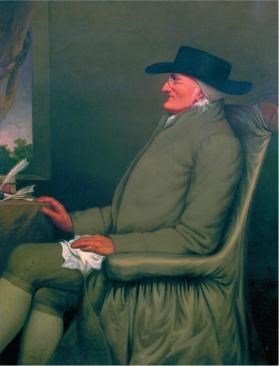
Painting of Moses Brown via NPS
On March 11, 1797, the Providence Abolition Society petitioned then-Attorney General Charles Lee, charging that the Ann, a ship of Cyprian and Samuel, had sailed under Samuel's command to travel to the African coast for enslaved people, even though this violated Rhode Island law. [17] A law had been passed in 1774 which made it illegal for citizens of the state to bring enslaved people into the state unless they had a bond to "bring them out again within one year" and those people brought to the state in defiance of the law would be "set free." However, the law caused slavers to sell captives in other ports while bringing their capital back to Rhode Island with them. The later was followed in later years, in 1787, by a measure which "banned participation by Rhode Islanders in the African slave trade." [18]
Some argued that the state's involvement in the slave trade was "part of a scramble by merchants to find something to trade and to market"with those involved earning a sizable profit. Following the enactment of the law in Rhode Island, similar laws passed in Connecticut and Massachusetts after being pressured by Quaker merchant merchant Moses Brown and Samuel Hopkins, a minister. The critical factor, according to I. Eliot Wentworth of University of Massachusetts Amherst's Special Collections & University Archives, of these laws was enforcing them, and when that did not happen, it lead to the creation of the Providence Society for Abolishing the Slave Trade. [19] It was mostly comprised of Quakers and had a membership of about 180 members. The society would face resistance from those invested in the trade, but still "played a valued role in supporting individuals of African descent in defending their rights in court." It won a judgement against Caleb Gardner, a merchant, in 1791, for "carrying out a slaving voyage in his brigantine Hope."
Cyprian, who owned half of the ships involved in the illegal slave trade, left it behind in order to avoid a crippling fine, signing a pledge to leave the slave trade forever, as did Samuel, from what I have read. [20] These efforts, like those of the Providence Abolition Society, were important since legislation against slave-trading in Rhode Island was hard to enforce, as noted earlier. For instance, a merchant and influential slaveowner named John Brown, a person who was instrumental in founding Brown University, tried in 1796 for violating the Slave Trade Act of 1794, prohibiting ships in American ports from bringing in enslaved people from any foreign country. At first he was convicted and his ship, the Hope, was confiscated for violation of federal law. However, as the case went through the legal system, he was ultimately acquitted, in a jury trial, "emerging with an acquittal and a judgment for costs against the Providence Abolition Society." [21] He even cited the arrangement the society made with Cyprian as part of a plea to stop prosecution against him.
As it turned out, the judge who presided over the case (Benjamin Bourn) and the federal prosecutor (Ray Greene) were allies of Brown, and the trial itself had a "devastating effect on the Providence Abolition Society, which went into a rapid decline." This was because, while by 1793, the Providence Society's activity had shifted to pushing for federal legislation, it remained dormant from February 1793 to November 1821. The Society was revived by David Howell and its name changed to the Providence Society for Promoting the Abolition of Slavery, continuing to meet until 1827. John later beat another prosecution in 1798, and in 1799, Samuel Bosworth, Surveyor of the Port of Bristol, was kidnapped by eight men dressed by Indigenous people, intimidating officials and putting a "halt to local enforcement of the Slave Trade Act" within Rhode Island.
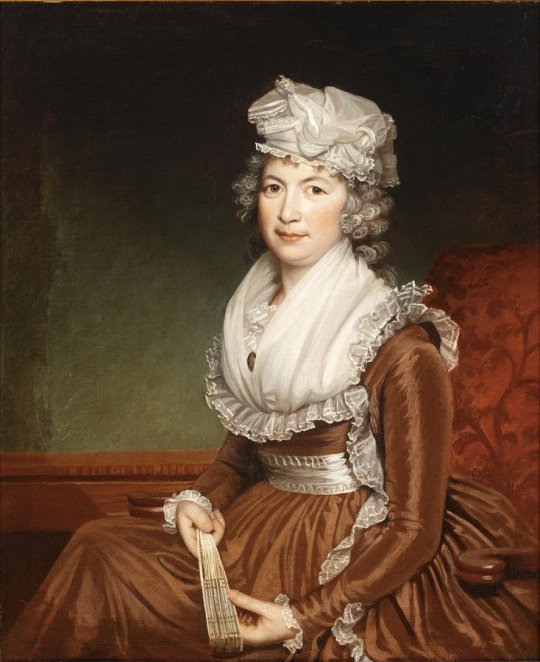
Via RISD, also painted by James Earl, and in the public domain
Samuel went onto become a wealthy shipowner and merchant who lived in a three-story-high lavish mansion in Providence with his wife Abigail Congdon. [22] He had married Abigail on December 13, 1789 at Saint Paul's Church in Rhode Island, with a Reverend William Smith as the minister. In 1798, Abigail inherited a portion of the Congdon homestead farm on Boston Neck. Samuel and Abigail had a number a children in later years, clearly living in Providence in 1800, just as he had in 1790. Their children included Abigail in 1802, Samuel in 1804, and Susan in 1806. By 1804, Samuel would work for the Providence Insurance Company, which ensured products like sugar, lived at Westminster Street in Providence (a property he bought in 1797). [23]
The Providence Insurance Company was founded on the initiative "of the Browns," including John, the arrogant slaver, in 1799. Other prominent shopping merchants, like Thomas Poynton Ives, John Innes Clarke, and Moses Lippitt, were on its board of directors. Samuel would be a member of the Providence Marine Society (PMS) and part of the Providence Marine Corps of Artillery after March 1803. [26] The latter group, founded in 1801 by PMS members, was a "private mutual aid society for sea captains," and while it later became part of the Rhode Island militia, the group itself "never served in active combat." The PMS, on the other hand, was a "mutual aid society for sea captains" founded in 1798.
Samuel also, reportedly, remembered George Washington fondly. This was not a surprise. In 1788, Olney Winsor, son of Samuel Windsor, a pastor of the Baptist Church of Providence, traveled to Alexandria on a sloop of which Samuel was the captain: the Susan. Both landed in Alexandria, went to a plantation at Col. Mason's Neck, seeing the control of slavemasters over those they enslaved firsthand, and met with George Washington himself.
By 1798, Cyprian was still living in Providence, owning a house, with a tenant: Brown & Ives, said to be a leader "in American commerce and industry for many years," and part of the Brown family which financed Brown University. [24] The company had been formed in a partnership between Nicholas Brown and Thomas Poynton Ives in 1791. The same year, Samuel is reported as having to have a summer house, house and barn, and perhaps another barn elsewhere in the city.
This wealth would not be possible without his involvement in the illegal slave trade which trafficked human beings from Africa back to the Americas in bondage. Let us be clear. Samuel, like Cyprian, might be called a human trafficker in today's language, if what he did happened today, although the comparison of present-day human trafficking and the transatlantic slave trade is not exact due to the differences between these oppressive systems of exploitation. [25] When they were alive, however, Samuel and Cyprian would likely be called slavers or slave traders. We don't know if Abigail had any role or say in Samuel's involvement in the trade, as we have no written records from her that I am aware of at this time. Even so, she still benefited from it, as she lived a life of luxury with Samuel until his death in 1820.
Samuel would also reportedly own land in Cranston, Rhode Island and in Illinois, along with a home in North Kingston, while building a house on the land his wife inherited on the death of her father, John Congdon. [27] Items from his houses are currently in RISD. John's grandfather, Benjamin, was reputed to be a huge slaveowner, while John, who had ten children with his wife, Abigail Rose. He received a tract of land of unknown acreage in Boston Neck, on his father's death, and then in October 1, 1803, Thomas R. Congdon sold one hundred and fifty acres of the farm to Samuel Packard, later known as the "Packard Farm," later reaching 500 acres. John's father, according to a 1765 listing, had seven enslaved people, one man (Coff), two young boys (Roshad and Tom), one woman (Tent), and three others (Cato, Fortune, and Jimie), working for him, which he manumitted at the time. [28]
In 1811, Samuel was aboard a ship when it French privateers raided the vessel, and how he tried to take back the ship, but was captured. [29] He would be at sea for eight days, then in a French prison for another eight days. They remained in France for another three months until they were allowed to go home. 17 years earlier, on February 4, 1794, France had abolished slavery, declaring that "all men irrespective of color living in the colonies are French citizens" but it was not reinforced, and Napoleon re-instituted it on July 16, 1802. He still remained in Providence, as he had in years prior, specifically in the city's West District. [30]
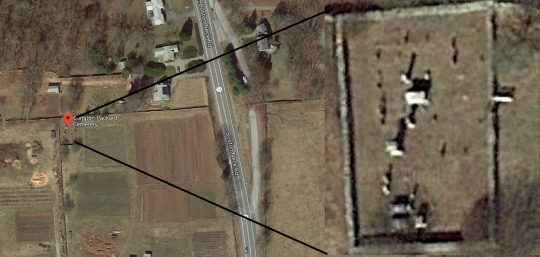
Screenshot of the cemetery where Samuel and Abigail are buried with a close-up of the cemetery taken from Google Earth
He died in July 1820, [31] while Abigail died in May 1854. Before her death, she established the Providence Female Charitable Society, which aided "indigent women and children." Both Samuel and Abigail are buried at Historic New England’s Casey Farm. While no wills or probates are available from them, both were of a higher class than others in Rhode Island and more broadly in New England. For Samuel, land ownership remained an important marker of civic identity and a measure of independence, as it was for other Americans, as historian Nancy Isenberg points out. This was based on the idea that people were not free unless they had "the economic wherewithal" to control their destiny, which comes from land ownership, deriving from an old English idea that the "quality of the soil determines the quality of the people."
Coming back to Samuel, his wealth derived, in part, as noted earlier, from trafficking enslaved Black people who were taken from their homelands by force. What he did was illegal, since the passage of a Rhode Island law in 1787 prohibiting it, and the Slave Trade Act of 1794, the latter with possible seizure of ships and a $2,000 fine, a law amended many times over the years until the Act Prohibiting Importation of Slaves passed in 1807. Even so, he still engaged in the trade despite the illegality, meaning, if he had been charged for his crimes, and convicted, he would have paid a total of $2,400, in, let's say, 1797. [32] This would likely have been a drop in the bucket for him. If assessed today, he would be paying $47,900.00, in terms of real price/real wealth, one of the most accurate measures, tied to CPI, according to Measuring Worth. In any case, what Samuel did went against "justice, integrity, and uprightness among people," in the words of the Quakers, who petitioned the Rhode Island legislature to abolish the slave trade in June 1787, participating in what they called an "unrighteous and inhuman trade to Africa for Slaves," complete with "cruel bondage."
Hopefully this article is a step in reworking and reframing narratives, as Adrienne Fikes pointed in June of this year. It is part of, what she talks about, in understanding who you are, who are in relation to others, who you come from, who your ancestors are, while looking at harm of past and its impact today. She also points out the value of sharing what you find with descendants of future generations, as does Donya Williams and Brian Sheffey of Genealogy Adventures (those who interviewed Fikes), noting the importance of think of microaggressions and pain involved in Black genealogy. Fikes also argues, rightly, that understanding structural racism, and noting the evolution of slavery, not seeing it in past tense. Furthermore, she says recognizing the humanity of people is important as is the current reality of dignity and humanity stolen from Black people, as is generational wealth. With this all being said, I look forward to hearing from you all as I continue to research my enslaved ancestors, as part of actively doing something to dismantle a system which privileges White people, uncovering more stories of my ancestors, even if it is difficult and disturbing at times to confront. [33]
Note: This was originally posted on Aug. 25, 2021 on the main Packed with Packards WordPress blog (it can also be found on the Wayback Machine here). My research is still ongoing, so some conclusions in this piece may change in the future.
© 2021-2022 Burkely Hermann. All rights reserved.
#slavery#packards#genealogy#family history#genealogy research#lineage#ancestry#slave trade#black history matters#black lives matter#rhode island#gambia#suriname#slave ships#18th century#19th century#public domain#senegambia#savannah#goree#havana#cuba#middle passage#cyprian sterry#black women#plantations#moses brown#abolitionists#james earl#george washington
2 notes
·
View notes
Text
I just spent an entire day untangling a knot in a friend's family tree. It turns out that about 100 years ago, some careless researcher accidentally smooshed together two guys with the same name, in spite of the fact that they lived in different states. Even though this person appears on nearly 500 people's family trees on Ancestry.com, and dozens of people have submitted him as their qualifying ancestor for the Sons/Daughters of the American Revolution, no one has ever taken a second look and thought, "Hmm ... it's a bit weird that this feller was still living in Pennsylvania 15 years after he died in Ohio."
Anyway, I think I have it all sorted out now, and I wrote up and posted a document explaining my reasoning, attached to his profile on the tree I made. I hope it is helpful to someone, and that I'm not about to have 100 angry DAR/SAR members show up at my door with torches and pitchforks because I said that their Revolutionary War Soldier Boy ancestor wasn't actually, and they're not as super special as they thought they were.
#genealogy#the dar/sar is bullshit#people just like to feel special i guess#u.s. history#revolutionary war#sloppy genealogy 'research' is one of my pet peeves#people will just copy and paste any old bullshit without a second look or thought
187 notes
·
View notes
Text
Carmen Sandiego's search for her roots comes to an end

The Chief looks at the file Jules has compiled on Carmen's mother
Reprinted from my Genealogy in Popular Culture WordPress blog. Originally published on Jan. 24, 2021.
In the past, on this blog, I've written about the family history themes in the animated series, Carmen Sandiego, especially in the show's first, second and third seasons. [1] The final episode of the series brought this full circle, after Julia "Jules" Argent, who had been tasked with finding Carmen's mother, talks with the Chief of ACME about what they know, which I talk about on my Wading Through The Cultural Stacks blog. Spoilers to anyone who has read this far. So, if you do not wish to be spoiled, then please don't read any further.
Anyway, the records that Jules and the Chief look at are very illuminating. They say the following:
Carmen's mother is Carlotta Valdez, born and raised in Vera Cruz, Mexico before moving to Buenos Aires, Argentina
She founded an orphanage six months after Dexter Wolfe's death
Wolfe was raising a family
What is amazing is they find this out by looking at travel records, photographs, and other evidence. They don't even need a DNA test from Carmen herself! Amazing work, Jules! Seriously. That's what makes this so great! I'm a big fan of using hard evidence rather than information from DNA tests, but I understand people having to use DNA. Still, no one should think that DNA is a be-all-end-all that will give them the true answers about their origins. That will, generally, only come from documents or perhaps oral stories. We see images of Carmen's mother in the episode, which I'm not sharing here, but she looks just like Carmen. In an attempt to bring in Carmen, ACME agents come near the orphanage where Carlotta works, but they don't enter it. Shadowsan does, and confirms that indeed this woman is Carmen's mother, seeing photographs of her and Wolff on a bookshelf, promising to tell her when she comes back "from the darkness" (she is currently in a state of being brainwashed by VILE to do their evil deeds).
Later in the episode, after VILE has been hobbled, she is handed a file about her past by Shadowsan and allowed to choose her own path. She is then shown on the streets of Buenos Aires and coming to the door of the orphanage to meet her mother.

Carmen walking down the streets of Buenos Aires, nervous about meeting her mother.
Best of luck to Carmen! This is such a great story of family discovery and ancestry that it should be shouted from the rooftops.
© 2021-2023 Burkely Hermann. All rights reserved.
Notes
[1] There's also an episode ("The V.I.L.E. History Caper") where Professor Maelstrom discusses his Norse ancestry, but it's so brief that writing a whole post about that really wouldn't be possible, to be honest.
© 2020-2023 Burkely Hermann. All rights reserved.
#carmen sandiego#roots#genealogy#pop culture#family history#argentina#latina#the chief#buenos aires#records#genealogy research#reviews
3 notes
·
View notes
Text
Finished reading through the Dungeon Meshi Adventurer's Bible last night. Very good, very interesting
One book down in my to-read pile... 7 to go lol
But! Something is bothering me about Half-foot naming conventions
The book says their names are like
FirstLast Father(s/z)
Ex. ChilChuck Tims
But Chilchuck's daughters are
Meijack Chils
Flertom Chils
Puckpatti Chils
(Or Chilz, couldn't find a definitive answer on how they write the father's name part)
So they all have different 'Last' names. Jack, Tom, Patti. All sisters with different 'last' names
So is it more like... a middle name? A second name? Then why does the book call it a 'last' name... especially when the father's name comes after??
Make it make sense
#i wonder if something was lost in translation you know#dungeon meshi#chilchuck tims#half-foots#naming conventions#i am aware that in iraq the 'father's name as last name' thing is common. which makes modern genealogy research in the area difficult#so that's not really unusual#but what's happening with the 'last' names here what is going on
22 notes
·
View notes
